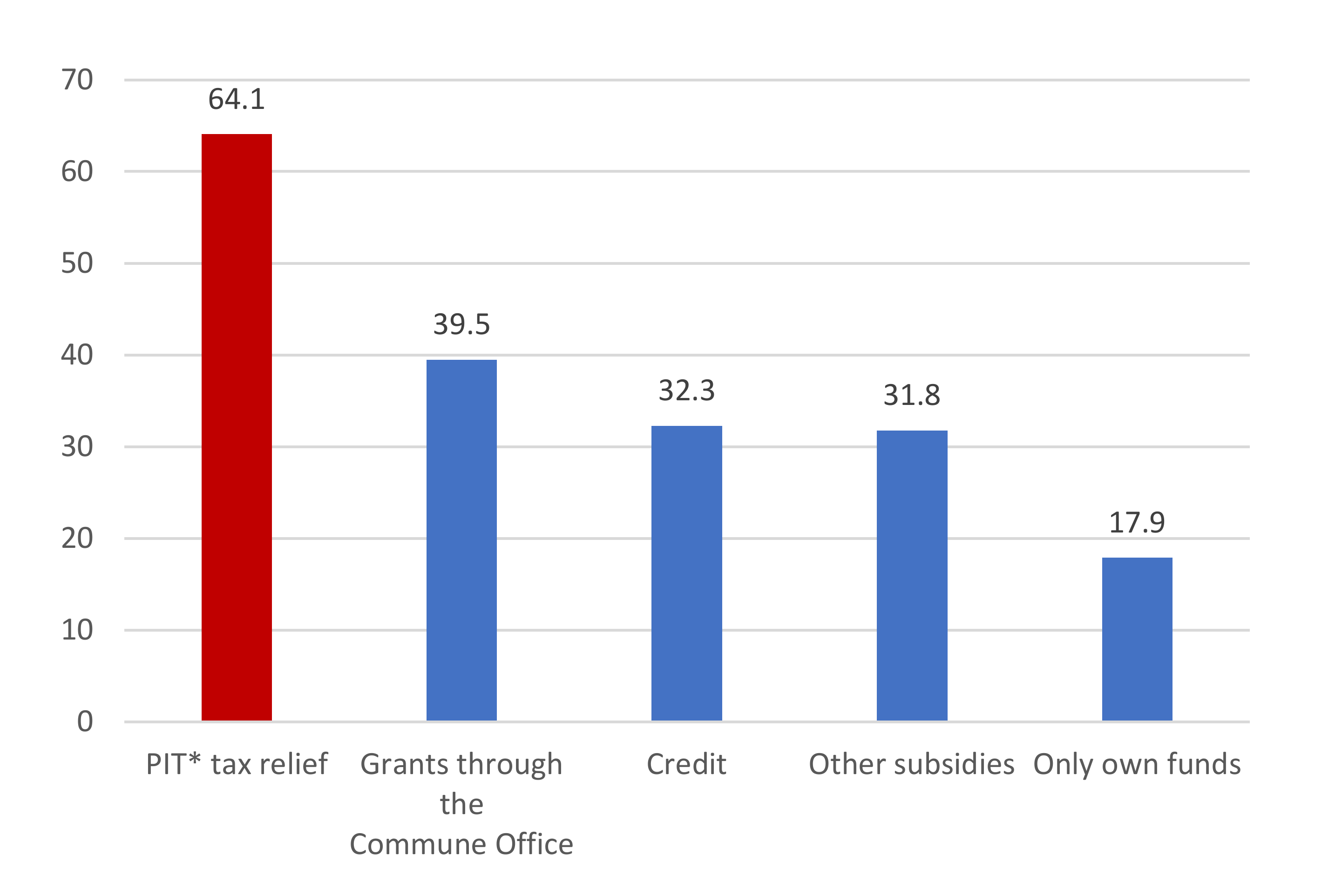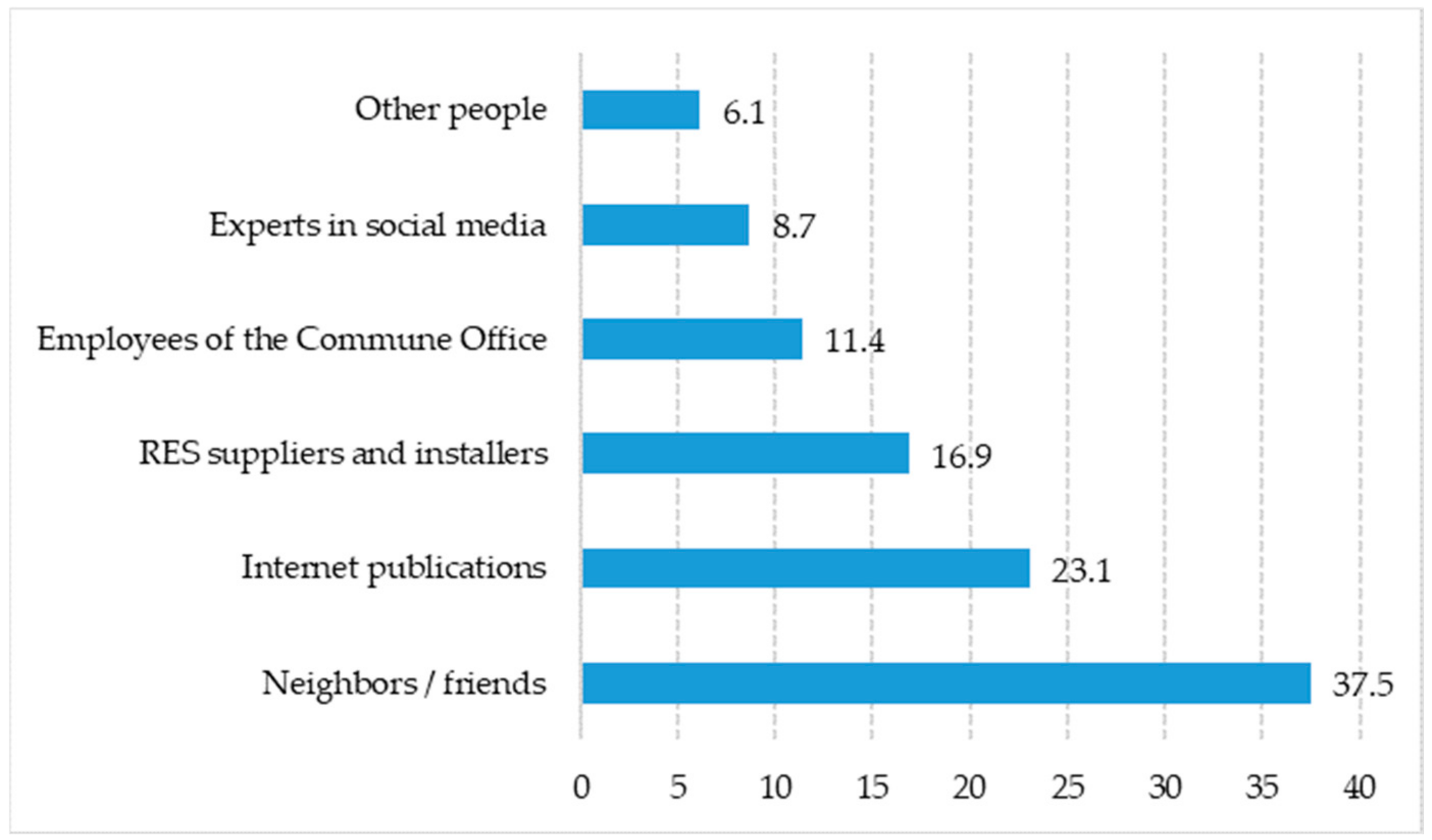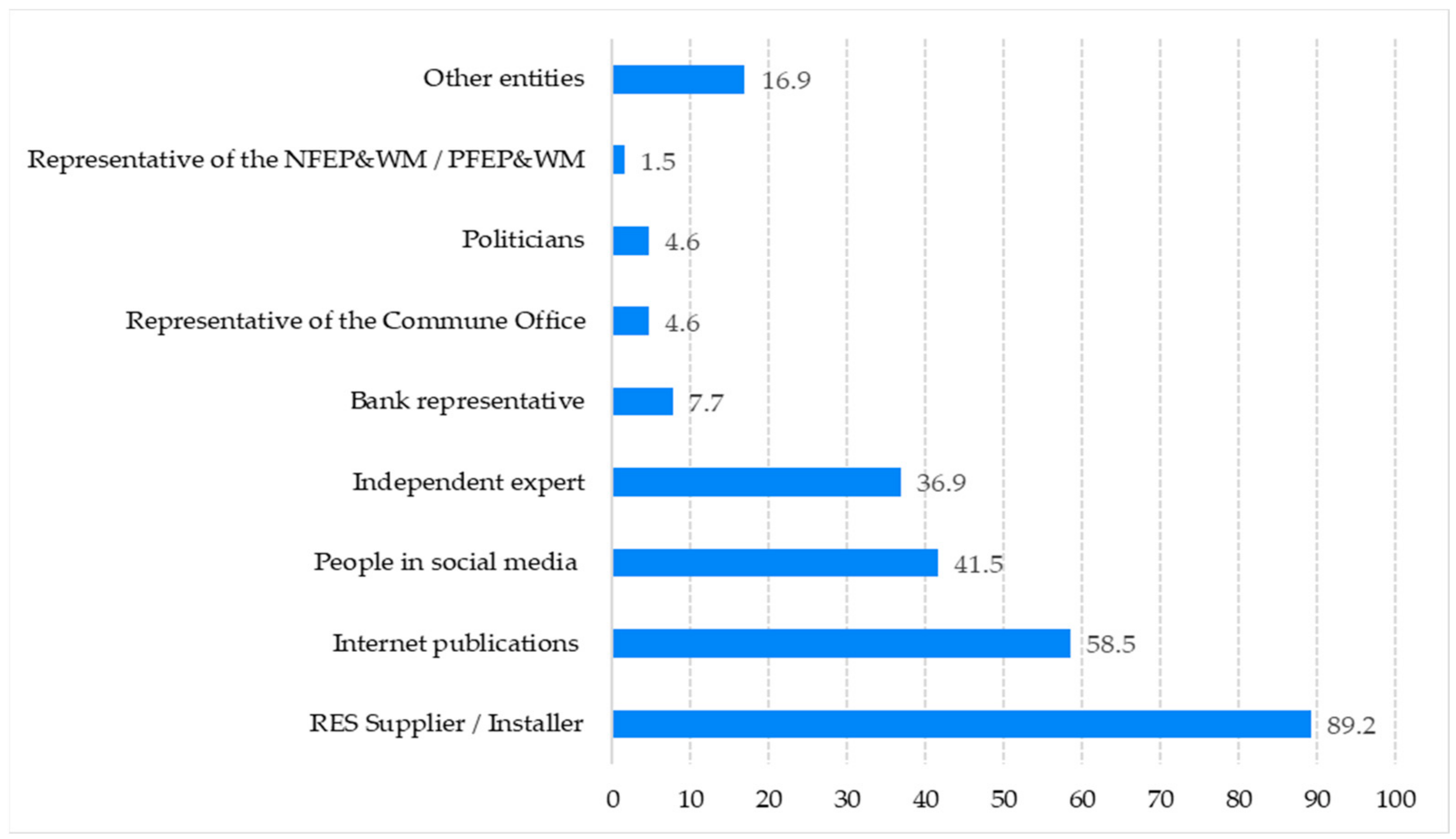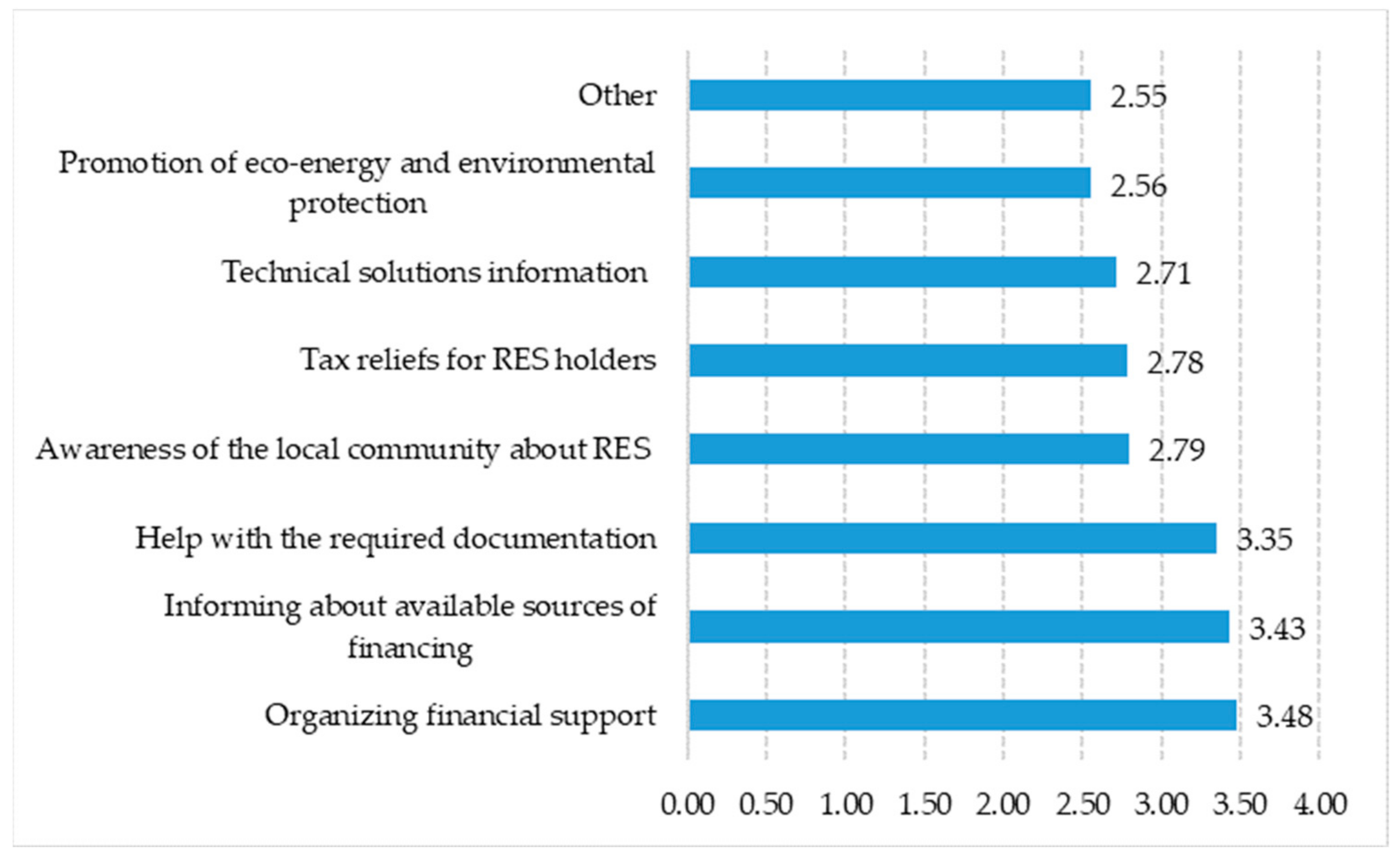The Role of Local Government in Implementing Renewable Energy Sources in Households (Podkarpacie Case Study)
Abstract
:1. Introduction
2. Literature Review
3. Rationale for the Involvement of Polish Municipalities in Supporting RES Installations in Households
- -
- maximizing the use of locally existing renewable energy potential;
- -
- supporting infrastructure investments of strategic importance for national energy security in the area of municipalities.
4. Materials and Methods
- Y1i = 1—If the ith household has implemented the RES installation thanks to the support of the municipality (under the umbrella project);
- Y1i = 0—If the ith household does not have such an installation
- where i = 1, 2, …, n—the number of surveyed households.
- C—C-Persona contingency coefficient;
- χ2—chi-squared;
- n—number of observations.
5. Results of Empirical Studies
5.1. Subsidies as a Source of Financing RES Installations in Households in Podkarpacie
5.2. Assessment of Support from the Municipalities by Beneficiaries of Umbrella Projects
6. Conclusions
Author Contributions
Funding
Institutional Review Board Statement
Informed Consent Statement
Data Availability Statement
Conflicts of Interest
References
- Council of the European Union; European Parliament. Directive (EU) 2018/2001 of the European Parliament and of the Council of 11 December 2018 on the promotion of the use of energy from renewable sources. Off. J. Eur. Union 2018, L 328, 82–209. [Google Scholar]
- Ministerstwo Aktywów Państwowych. National Energy and Climate Plan for the Years 2021–2030 (Krajowy Plan na Rzecz Energii i Klimatu na Lata 2021–2030. Założenia i Cele Oraz Polityki i Działania). Ministerstwo Aktywów Państwowych: Warszawa, Poland, 18 December 2019. [Google Scholar]
- Kata, R.; Cyran, K.; Dybka, S.; Lechwar, M.; Pitera, R. Economic and Social Aspects of Using Energy from PV and Solar Installations in Farmers’ Households in the Podkarpackie Region. Energies 2021, 14, 3158. [Google Scholar] [CrossRef]
- Kosiński, E.; Trupkiewicz, M. Gmina jako podmiot systemu wspierania wytwarzania energii elektrycznej z odnawialnych źródeł energii (A municipality as a part of the suport system for generetion of electricity from renewable Energy sources). Praw. Ekon. Socjol. 2016, 78, 93–107. [Google Scholar] [CrossRef] [Green Version]
- Standar, A.; Kozera, A.; Satoła, Ł. The Importance of Local Investments Co-Financed by the European Union in the Field of Renewable Energy Sources in Rural Areas of Poland. Energies 2021, 14, 450. [Google Scholar] [CrossRef]
- Comodi, G.; Cioccolanti, L.; Polonara, F.; Brandoni, C. Local authorities in the context of energy and climate policy. Energy Policy 2012, 51, 737–748. [Google Scholar] [CrossRef]
- United Nations. United Nations Sustainable Development Goals Report 2016; U.N. Publications: New York, NY, USA, 2016. [Google Scholar]
- Sperling, K.; Hvelplund, F.; Mathiesen, B.V. Centralisation and decentralisation in strategic municipal energy planning in Denmark. Energy Policy 2011, 39, 1338–1351. [Google Scholar] [CrossRef]
- Mey, F.; Diesendorf, M.; MacGill, I. Can local government play a greater role for community renewable energy? A case study from Australia. Energy Res. Soc. Sci. 2016, 21, 33–43. [Google Scholar] [CrossRef]
- Denis, G.S.; Parker, P. Community energy planning in Canada: The role of renewable Energy. Renew. Sustain. Energy Rev. 2009, 13, 2088–2095. [Google Scholar] [CrossRef]
- Walker, G.; Hunter, S.; Devine-Wright, P.B. Evans, Harnessing communityenergies: Explaining and evaluating community-based localism inrenewable energy policy in the UK. Glob. Environ. Politics 2007, 7, 64–82. [Google Scholar] [CrossRef]
- Haggett, C.; Creamer, E.; Harnmeijer, J.; Parsons, M.; Bomberg, E. Community Energy in Scotland: The Social Factors for Success; University of Edinburgh: Edinburgh, UK, 2013; pp. 1–25. [Google Scholar]
- Rakowska, J.; Ozimek, I. Renewable Energy Attitudes and Behaviour of Local Governments in Poland. Energies 2021, 14, 2765. [Google Scholar] [CrossRef]
- Klepacki, B.; Kusto, B.; Bórawski, P.; Bełdycka-Bórawska, A.; Michalski, K.; Perkowska, A.; Rokicki, T. Investments in Renewable Energy Sources in Basic Units of Local Government in Rural Areas. Energies 2021, 14, 3170. [Google Scholar] [CrossRef]
- Yaqoot, M.; Diwan, P.; Kandpal, T.C. Review of barriers to the dissemination of decentralized renewable energy systems. Renew. Sustain. Energy Rev. 2016, 58, 477–490. [Google Scholar] [CrossRef]
- Graczyk, A.M.; Graczyk, A.; Żołyniak, T. System for Financing Investments in Renewable Energy Sources in PolandFinance and SustainabilitySpringer: Cham, Switzerland, 2020; pp. 153–166. [CrossRef]
- Stokes, L.C.; Breetz, H.L. Politics in the U.S. energy transition: Case studies of solar, wind, biofuels and electric vehicles policy. Energy Policy 2018, 113, 76–86. [Google Scholar] [CrossRef] [Green Version]
- Kata, R.; Lechwar, M.; Dybka, S.; Cyran, K.; Pitera, R. Kredytowanie Inwestycji Związanych z Energetyką Odnawialną Realizowanych Przez JST Oraz Podmioty ze Sfery Mieszkalnictwa, Raport Opracowany na Zlecenie Programu Analityczno-Badawczego Fundacji Warszawski Instytut Bankowości, SYGN; WIB PAB 24/2020; Instytut Ekonomii i Finansów-Uniwersytet Rzeszowski: Warszawa, Poland, 2020. [Google Scholar]
- Brandoni, C.; Polonara, F. Technical and economic aspects of municipal energy planning. Int. J. Sustain. Dev. Plan. 2012, 7, 221–236. [Google Scholar] [CrossRef] [Green Version]
- Scorza, F.; Santopietro, L. A systemic perspective for the Sustainable Energy and Climate Action Plan (SECAP). In European Planning Studies; Taylor & Francis: New York, NY, USA, 2021; pp. 1–21. [Google Scholar] [CrossRef]
- West, J.; Bailey, I.; Winter, M. Renewable energy policy and public perceptions of renewable energy: A cultural theory approach. Energy Policy 2010, 38, 5739–5748. [Google Scholar] [CrossRef]
- Kim, K.-K.; Lee, C.-G. Evaluation and optimization of feed-in-tariffs. Energy Policy 2012, 49, 129–203. [Google Scholar] [CrossRef]
- Islam, T.; Meade, N. The impact of attribute preferences on adoption timing: The case of photo-voltaic (PV) solar cells for household electricity generation. Energy Policy 2013, 55, 521–530. [Google Scholar] [CrossRef] [Green Version]
- IEA International Energy Agency. Cities, Towns & Renewable Energy, Yes in My Front Yard; IEA: Paris, France, 2009. [Google Scholar]
- Karanasios, K.; Parker, P. Explaining the Diffusion of Renewable Electricity Technologies in Canadian Remote Indigenous Communities through the Technological Innovation System Approach. Sustainability 2018, 10, 3871. [Google Scholar] [CrossRef] [Green Version]
- Michalena, E.; Angeon, V. Local challenges in the promotion of renewable energy sources: The case of Crete. Energy Policy 2009, 37, 2018–2026. [Google Scholar] [CrossRef]
- Allman, L.; Fleming, P.; Wallace, A. The progress of English andWelsh local authorities in addressing climate change. Local Environ. 2004, 9, 271–283. [Google Scholar] [CrossRef]
- Ustawa z Dnia 20 Maja 2016 r. O Inwestycjach w Zakresie Elektrowni Wiatrowych, Dz.U. 2016 poz. 961. Available online: https://isap.sejm.gov.pl/isap.nsf/DocDetails.xsp?id=WDU20160000961 (accessed on 15 March 2022).
- Rapacka, P.; Marszałkowski, M. Kaszubski Spór o Wiatraki z Ustawą Odległościową w Tle, Biznes Alert, 29 June 2020. Available online: https://biznesalert.pl/wyczechowo-oze-farma-wiatrowa-ustawa-odleglosciowa-konflikt-spoleczny-energetyka (accessed on 13 March 2022).
- Przepisy Blokują Inwestycje w Elektrownie Wiatrowe, Portal Komunalny, 10 February 2020. Available online: https://portalkomunalny.pl/przepisy-blokuja-inwestycje-w-elektrownie-wiatrowe-400344 (accessed on 13 March 2022).
- Liberalizacja Ustawy Odległościowej Jest Coraz Bliżej. Zrobiono Ważny krok, WNP.pl Energetyka, 5 March 2022. Available online: https://www.wnp.pl/energetyka/liberalizacja-ustawy-odleglosciowej-jest-coraz-blizej-zrobiono-wazny-krok,518053.html (accessed on 13 March 2022).
- Zoellner, J.; Schweizer-Ries, P.; Wemheuer, C. Public acceptance of renewable energies: Results from case studies in Germany. Energy Policy 2008, 36, 4136–4141. [Google Scholar] [CrossRef]
- Szakály, Z.; Balogh, P.; Kontor, E.; Gabnai, Z.; Bai, A. Attitude toward and Awareness of Renewable Energy Sources: Hungarian Experience and Special Features. Energies 2021, 14, 22. [Google Scholar] [CrossRef]
- Qazi, A.; Hussain, F.; Rahim, N.; Hardaker, G.; Alghazzawi, D.; Shaban, K.; Hakurna, K. Towards Sustainable Energy: A Systematic Review of Renewable Energy Sources, Technologies, and Public Opinions. IEEE Access 2019, 7, 63837–63851. [Google Scholar] [CrossRef]
- Bai, A.; Durkó, E.; Tar, K.; Tóth, J.B.; Lázár, I.; Kapocska, L.; Kircsi, A.; Bartók, B.; Vass, R.; Pénzese, J.; et al. Social and economic possibilities for the energy utilization of fitomass in the valley of the river Hernád. Renew. Energy 2016, 85, 777–789. [Google Scholar] [CrossRef]
- Owczarek, D.; Miazga, A. Ubóstwo Energetyczne w Polsce—Definicja i Charakterystyka Społeczna Grupy; Instytut na Rzecz Ekorozwoju: Warszawa, Poland, 2015. [Google Scholar]
- Śmiech, S.; Karpińska, L. Energetyczna Bieda; Raport o gospodarstwach domowych ubogich energetycznie; Parlamentarny Zespół ds. Suwerenności Energetycznej: Poland, Warszawa, 2021. [Google Scholar]
- Bouzarovski, S.; Thomson, H.; Cornelis, M. Confronting Energy Poverty in Europe: A Research and Policy Agenda. Energies 2021, 14, 858. [Google Scholar] [CrossRef]
- EEN. EnR Position Paper on Energy Poverty in the European Union; European Energy Network: Roma, Italy, 2019. [Google Scholar]
- Thomson, H.; Bouzarovski, S.; Snell, C. Rethinking the measurement of energy poverty in Europe: A critical analysis of indicators and data. Indoor Built Environ. 2017, 26, 879–901. [Google Scholar] [CrossRef]
- Biernat-Jarka, A.; Trębska, P.; Jarka, S. The Role of Renewable Energy Sources in Alleviating Energy Poverty in Households in Poland. Energies 2021, 14, 2957. [Google Scholar] [CrossRef]
- Lee, J.; Shepley, M.M. Benefits of solar photovoltaic systems for low-income families in social housing of Korea: Renewable energy applications as solutions to energy poverty. J. Build. Eng. 2020, 28, 101016. [Google Scholar] [CrossRef]
- Obwieszczenie Ministra Gospodarki z 21.12.2009 r. w Sprawie Polityki Energetycznej Państwa do 2030 r. (M.P. z 2010 r. Nr 2, poz. 1). Available online: https://isap.sejm.gov.pl/isap.nsf/DocDetails.xsp?id=WMP20100020011 (accessed on 15 March 2022).
- Szyrski, M. Ocena realizacji konstytucyjnej zasady pomocniczości w prawie odnawialnych źródeł energii. Samorząd Terytorialny 2018, 5, 21–31. [Google Scholar]
- Informacja Dotycząca Projektów Parasolowych, Województwo Podkarpackie, Rzeszów 2016. Available online: https://www.rpo.podkarpackie.pl/images/dok/2016/pytania_i_odpowiedzi/3.1/Informacje_do_umieszczenia_przy_og%C5%82oszeniu_naboru_3.1_projekty_parasolowe.pdf (accessed on 13 March 2022).
- Central Statistical Office. Zużycie Energii w Gospodarstwach Domowych w 2018 r; GUS (Central Statistical Office): Warszawa, Poland, 2019. [Google Scholar]
- Sokołowski, J.; Frankowski, J. Jak Poprawić Jakość Życia Osób Ubogich Energetycznie? Instytut Badań Strukturalnych. IBS Policy Paper. 2021. Available online: https://ibs.org.pl/publications/jak-poprawic-jakosc-zycia-osob-ubogich-energetycznie/ (accessed on 13 March 2022).
- Boguszewski, R.; Herudziński, T. Ubóstwo Energetyczne w Polsce; Pracownia Badań Społecznych SGGW: Warszawa, Poland, 2018. [Google Scholar]
- Central Statistical Office. Energia ze Źródeł Odnawialnych w 2018 r; GUS (Central Statistical Office): Warszawa, Poland, 2019. [Google Scholar]
- EEA. Air Quality in Europe—2015 Report. Raport Europejskiej Agencji Środowiska (EEA), 9 January 2021. 2015. Available online: https://www.eea.europa.eu//publications/air-quality-in-europe-2015 (accessed on 15 March 2022).
- Central Statistical Office. Budżety Gospodarstw Domowych w 2019 r; GUS (Central Statistical Office): Warszawa, Poland, 2020. [Google Scholar]
- Lewandowski, P.; Kiełczewska, A.; Ziółkowska, K. Zjawisko Ubóstwa Energetycznego w Polsce, w Tym ze Szczególnym Uwzględnieniem Zamieszkujących w Domach Jednorodzinnych; IBS Research Report 02/2018; Instytut Badań Strukturalnych: Warszawa, Poland, 2018. [Google Scholar]
- Monitorowanie Strategii Rozwoju Województwa—Podkarpackie 2030. Bezpieczeństwo Energetyczne i Racjonalne Wykorzystanie Energii, Podkarpackie Regionalne Obserwatorium Terytorialne, Rzeszów 2022. Available online: https://rot.podkarpackie.pl/index.php/srodowisko-i-energetyka/4-3-bezpieczenstwo-energetyczne-i-racjonalne-wykorzystanie-energii (accessed on 15 March 2022).
- Central Statistical Office. Narodowy Spis Rolny 2020. Raport z Wyników (National Agricultural Census 2020. Report on the Results); GUS (Central Statistical Office): Warszawa, Poland, 2021. [Google Scholar]
- Central Statistical Office. Energia ze Źródeł Odnawialnych w 2020 Roku. Informacje Sygnalne; GUS (Central Statistical Office): Warszawa, Poland, 2021. [Google Scholar]
- Nowak, S. Metodologia Badań Społecznych; Wydawnictwo Naukowe: Warszawa, Poland, 2007. [Google Scholar]
- Raport z Badania Ewaluacyjnego “Ocena Wpływu RPO WP 2014–2020 na Efektywność Energetyczną i Emisyjność”, Urząd Marszałkowski Województwa Podkarpackiego, Marzec 2022. Available online: https://rpo.podkarpackie.pl/images/ewaluacja/badania_ewaluacyjne/OP_III/Raport_końcowy_ENERGIA_final_15_03.pdf (accessed on 17 March 2022).
- Urząd Statystyczny w Rzeszowie. Zamieszkane Budynki w Województwie Podkarpackim, Narodowy Spis Powszechny Ludności i Mieszkań 2011; Urząd Statystyczny w Rzeszowie: Rzeszów, Poland, 2013. [Google Scholar]
- Cramer, J.S. Logit Models from Economic and Other Fields; Cambridge University Press: Cambridge, UK, 2003. [Google Scholar]
- Maddala, G.S. Ekonometria; Wydawnictwo Naukowe PWN: Warszawa, Poland, 2008. [Google Scholar]
- Urząd Regulacji Energetyki. Raport Zawierający Zbiorcze Informacje Dotyczące Energii Elektrycznej Wytworzonej z Odnawialnego Źródła Energii w Mikroinstalacji (w Tym Przez Prosumentów) i Wprowadzonej do Sieci Dystrybucyjnej w 2020 r; Urząd Regulacji Energetyki: Warszawa, Poland, 2021. [Google Scholar]
- Ustawa z Dnia 9 Listopada 2018 r. o Zmianie Ustawy o Podatku Dochodowym od Osób Fizycznych Oraz Ustawy o Zryczałtowanym Podatku Dochodowym od Niektórych Przychodów Osiąganych Przez Osoby Fizyczne; Dz.U. 2018 poz. 2246. Available online: https://isap.sejm.gov.pl/isap.nsf/DocDetails.xsp?id=WDU20180002246 (accessed on 17 March 2022).
- Resolution of the Sejmik of Podkarpackie Voivodeship No LII/869/18 of 23 April 2018. Available online: http://edziennik.rzeszow.uw.gov.pl/WDU_R/2018/2498/akt.pdf (accessed on 17 March 2022).
- Ropuszyńska-Surma, E.; Węglarz, M. Bariery rozwoju rozproszonej energetyki odnawialnej w świetle badań ankietowych. Przegląd Elektrotechniczny 2017, 1, 90–94. [Google Scholar] [CrossRef]
- Su, W.; Liu, M.; Zeng, S.; Štreimikienė, D.; Baležentis, T.; Ališauskaitė-Šeškienė, I. Valuating renewable microgeneration technologies in Lithuanian households: A study on willingness to pay. J. Clean. Prod. 2018, 191, 318–329. [Google Scholar] [CrossRef]
- Borkowski, K.; Ćwikliński, H. Ewolucja instrumentów regulacyjnych wspierających rozwój mikroinstalacji w Polsce w latach 2005–2019—Wybrane zagadnienia. Studia Orientalne 2020, 1, 117–141. [Google Scholar] [CrossRef]
- Siedlecka, A.; Graszko, B. Odnawialne źródła energii jako narzędzie oddziaływania na jakość życia gospodarstw domowych. Rocz. Nauk. Stowarzyszenia Ekon. Rol. I Agrobiz. 2016, 18, 237–242. [Google Scholar]
- Juszczyk, O.; Juszczyk, J.; Juszczyk, S.; Takala, J. Barriers for Renewable Energy Technologies Diffusion: Empirical Evidence from Finland and Poland. Energies 2022, 15, 527. [Google Scholar] [CrossRef]
- Palm, J. Household installation of solar panels—Motives and barriers in a 10-year perspective. Energy Policy 2018, 113, 1–8. [Google Scholar] [CrossRef] [Green Version]






| Gender | Age [y] | Education | Income per 1 Person (PLN) | |||||||||
|---|---|---|---|---|---|---|---|---|---|---|---|---|
| Male | Female | To 39 | 40–59 | 60 and More | Primary | Vocational | Secondary | Higher | To 1000 | 1001–2000 | 2001–3000 | Over 3000 |
| 50.8 | 49.2 | 36.4 | 37.4 | 26.2 | 14.9 | 30.8 | 37.4 | 16.9 | 21.0 | 22.6 | 32.3 | 24.1 |
| Variable | Symbol |
|---|---|
| Methods of informing and encouraging investment (points −2 ÷ 2) | X1 |
| Quality of consulting (points −2 ÷ 2) | X2 |
| Amount of the subsidy (PLN) | X3 |
| Degree of complexity of the documentation (points −2 ÷ 2) | X4 |
| Speed of investment implementation (the time from the notification of the willingness to purchase the installation to the completion of the investment) (points −2 ÷ 2) | X5 |
| Impact on the reduction of bills (points 1 ÷ 5) | X6 |
| Flexibility and individual approach to the client (points −2 ÷ 2) | X7 |
| Quality of the offered and installed devices (points −2 ÷ 2) | X8 |
| Flow of information about progress of investment (points −2 ÷ 2) | X9 |
| Possibility of choosing the installation to customer expectations (points −2 ÷ 2) | X10 |
| Quality of the installation service (selection of professional assembly teams) (points −2 ÷ 2) | X11 |
| Quality of technical supervision (inspection and acceptance of the installation) (points −2 ÷ 2) | X12 |
| Variable | Factor | Standard Error | Statistics t | p-Value |
|---|---|---|---|---|
| Const | 1.6252 | 1.9274 | 0.8431 | 0.4002 |
| The methods of informing and encouraging investment | 0.5440 | 0.2902 | 2.0152 | 0.0237 |
| X4—The degree of complexity of the documentation | −0.7352 | 0.2493 | −2.0390 | 0.0209 |
| X5—Speed of investment implementation(the time from the notification of purchase the installation to the completion of the investment) | −0.5376 | 0.2625 | −2.0050 | 0.0306 |
| X6—Impact on the reduction of bills | 0.5537 | 0.2371 | 2.3352 | 0.0206 |
| X9—Flow of information about progress of investment | 0.9296 | 0.3699 | 2.5129 | 0.0128 |
| Number of observations = 195; p-value = 0.05; Number of cases of correct prediction 90.3%; Chi-square = 92.7%; Corrected R2 = 0.41; McFadden R2 = 0.56. | ||||
| Total | Age [y] | Income [PLN **] | ||||||
|---|---|---|---|---|---|---|---|---|
| To 39 | 40–59 | 60 and More | To 1000 | 1001–2000 | 2001–3000 | Over 3000 | ||
| The methods of informing and encouraging investment | −0.09 | 0.03 | −0.36 | 0.67 | 0.00 | 0.00 | 0.06 | −0.23 |
| The quality of consulting | −0.02 | −0.03 | −0.04 | 0.33 | 0.33 | −0.15 | 0.11 | −0.07 |
| The amount of the subsidy | −0.14 | −0.03 | −0.25 | −0.67 | 0.67 | 0.31 | −0.17 | −0.41 |
| The degree of complexity of the documentation | −0.34 | −0.33 | −0.44 | 0.33 | −1.00 | −0.23 | 0.00 | −0.53 |
| Speed of investment implementation | 0.04 | −0.03 | 0.04 | 0.00 | −0.33 | −0.69 | 0.33 | 0.13 |
| Impact on the reduction of bills | −0.28 | −0.06 | −0.58 | −0.33 | 0.33 | 0.43 | −0.71 | −0.43 |
| Flexibility and individual approach to the client | −0.08 | 0.00 | −0.24 | 0.33 | −0.33 | −0.15 | −0.06 | −0.03 |
| The quality of the offered & installed devices | −0.09 | −0.06 | −0.16 | 0.00 | 0.33 | 0.00 | 0.00 | −0.23 |
| Flow of information about progress of investment | 0.37 | 0.36 | 0.36 | 0.67 | 0.33 | 0.00 | 0.56 | 0.43 |
| Possibility of choosing the installation to customer expectations | −0.25 | −0.14 | −0.44 | 0.00 | 1.00 | −0.31 | −0.39 | −0.27 |
| The quality of the installation service (selection of assembly teams) | 0.22 | 0.33 | −0.04 | 1.00 | 0.67 | 0.38 | 0.22 | 0.10 |
| Quality of technical supervision | 0.68 | 0.33 | −0.04 | 1.00 | 0.67 | 0.38 | 0.22 | 0.10 |
| Total | Age [y] | Income [PLN **] | ||||||
|---|---|---|---|---|---|---|---|---|
| To 39 | 40–59 | 60 and More | To 1000 | 1001–2000 | 2001–3000 | Over 3000 | ||
| Independent expert | 0.56 | 0.43 | 0.71 | 1.00 | 0.67 | −0.36 | 0.72 | 0.80 |
| Representative of the Commune Office | 0.47 | 0.49 | 0.46 | 0.33 | 0.67 | −0.09 | 0.28 | 0.77 |
| Internet publications | 0.44 | 0.49 | 0.32 | 1.00 | 0.33 | 0.17 | 0.22 | 0.70 |
| People in social media | 0.43 | 0.34 | 0.52 | 0.67 | −0.67 | −0.58 | 0.44 | 0.93 |
| Representative of the NFEP&WM/PFEP&WM | 0.39 | 0.54 | 0.21 | 0.00 | 0.67 | 0.09 | 0.22 | 0.57 |
| Other entities | 0.38 | 0.41 | 0.39 | 0.00 | 0.00 | −0.14 | 0.60 | 0.43 |
| Bank representative | 0.08 | −0.03 | 0.19 | 0.33 | 1.00 | 0.00 | 0.11 | 0.00 |
| RES Supplier/Installer | −0.27 | −0.06 | −0.54 | −0.67 | 0.00 | 0.36 | −0.39 | −0.47 |
| Politicians | −1.49 | −1.40 | −1.68 | −1.67 | −1.33 | −1.25 | −1.44 | −1.70 |
| Specification | Respondents | ||
|---|---|---|---|
| Age | Education | Income per Capita | |
| Assessment of selected elements of support for RES investments by the Commune Office | |||
| Methods of informing and encouraging Investment | p = 0.0030 C = 0.311 | p = 0.0001 C = 0.354 | p = 0.0135 C = 0.248 |
| Quality of consulting | p = 0.1391 | p < 0.0001 C = 0.328 | p = 0.0034 C = 0.274 |
| Amount of the subsidy | p = 0.0095 C = 0.283 | p = 0.0001 C = 0.314 | p = 0.0001 C = 0.327 |
| Degree of complexity of the documentation | p = 0.0471 C = 0.249 | p = 0.0794 | p = 0.597 |
| Speed of investment implementation | p = 0.0079 C = 0.288 | p = 0.0070 C = 0.260 | p < 0.0001 C = 0.353 |
| Flexibility and individual approach to the client | p = 0.0315 C = 0.247 | p = 0.0019 C = 0.285 | p = 0.0019 C = 0.285 |
| Quality of the offered and installed devices | p = 0.0705 | p = 0.0976 | p = 0.0056 C = 0.265 |
| Flow of information about progress of investment | p = 0.5519 | p < 0.0001 C = 0.381 | p < 0.0001 C = 0.484 |
| Possibility of choosing the installation to customer expectations | p < 0.0001 C = 0.347 | p < 0.0001 C = 0.373 | p = 0.0522 |
| Quality of the installation service | p < 0.0001 C = 0.356 | p = 0.0147 C = 0.251 | p = 0.2019 |
| Quality of technical supervision | p < 0.0001 C = 0.481 | p < 0.0001 C = 0.366 | p < 0.0001 C = 0.352 |
| Credibility assessment of the entity encouraging RES installation | |||
| RES supplier/installer | p < 0.0001 C = 0.409 | p = 0.3537 | p < 0.0001 C = 0.398 |
| Representative of the Commune Office | p < 0.0001 C = 0.379 | p = 0.0013 C = 0.291 | p = 0.0406 C = 0.253 |
| Bank representative | p = 0.239 | p < 0.0001 C = 0.351 | p < 0.0001 C = 0.407 |
| Representative of the NFEP&WM/PFEP&WM | p = 0.0016 C = 0.320 | p < 0.0001 C = 0.433 | p < 0.0001 C = 0.366 |
| Independent expert | p = 0.0016 C = 0.363 | p = 0.0017 C = 0.291 | p < 0.0001 C = 0.450 |
| Internet publications | p < 0.0001 C = 0.386 | p = 0.0002 C = 0.333 | p = 0.0014 C = 0.320 |
Publisher’s Note: MDPI stays neutral with regard to jurisdictional claims in published maps and institutional affiliations. |
© 2022 by the authors. Licensee MDPI, Basel, Switzerland. This article is an open access article distributed under the terms and conditions of the Creative Commons Attribution (CC BY) license (https://creativecommons.org/licenses/by/4.0/).
Share and Cite
Kata, R.; Cyran, K.; Dybka, S.; Lechwar, M.; Pitera, R. The Role of Local Government in Implementing Renewable Energy Sources in Households (Podkarpacie Case Study). Energies 2022, 15, 3163. https://doi.org/10.3390/en15093163
Kata R, Cyran K, Dybka S, Lechwar M, Pitera R. The Role of Local Government in Implementing Renewable Energy Sources in Households (Podkarpacie Case Study). Energies. 2022; 15(9):3163. https://doi.org/10.3390/en15093163
Chicago/Turabian StyleKata, Ryszard, Kazimierz Cyran, Sławomir Dybka, Małgorzata Lechwar, and Rafał Pitera. 2022. "The Role of Local Government in Implementing Renewable Energy Sources in Households (Podkarpacie Case Study)" Energies 15, no. 9: 3163. https://doi.org/10.3390/en15093163
APA StyleKata, R., Cyran, K., Dybka, S., Lechwar, M., & Pitera, R. (2022). The Role of Local Government in Implementing Renewable Energy Sources in Households (Podkarpacie Case Study). Energies, 15(9), 3163. https://doi.org/10.3390/en15093163






